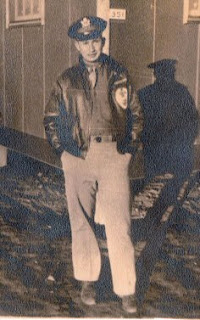----------
 |
| Lt. Munday in 1942 |
Before he could depart for overseas duty, the Air Force commandeered his squadron's B-24s for anti-submarine duty and switched Lt. Munday over to the venerable B-17 "Flying Fortress." With barely more than a few hours to get "checked out" on the B-17, Lt. Munday found himself and a crew ferrying their own B-17 over to the 384th Bomb Group at Grafton Underwood, England, which would be their base for the duration of the war.
Bastille Day, July 14, 1943 found the Americans engaged in a "maximum effort" assault to show our French allies that we were determined to win their freedom and achieve victory over the Nazis. After bombing the Nazi-occupied Villacoublay Airfield and aircraft factories outside Paris, Lt. Munday and his crew succumbed to enemy flak and strafing from Focke-Wulf 190s. Lt. Munday himself took an enemy machine gun round from a FW 190 in the leg. Keeping the B-17 aloft while his crew bailed out, Lt. Munday finally bailed out almost too low for safety.
 | |||||||||
| Col. Munday (2nd from left) with Alex Gotovsky (left) |
The treatment and recovery from the wound in Munday's leg would take many weeks. Finally, with the help of the French Underground, Lt. Munday was disguised as a French surveyor, equipped with forged identity papers and sent south. Being out of uniform and in civilian clothes with forged papers meant Munday would be shot as a spy if caught. The long journey led over the Pyrenees (traveling through the mountains at night on foot) to Barcelona, then Madrid, then at last to Gibraltar, where he could secure a flight that would take him back to his base in England.
 |
| Col. Munday in 1963 |
In 1997, Col. Munday returned to the village of Les Essarts-le-Roi where he was awarded a medal and had the opportunity to be reunited with Alex Gotovsky, the young boy who had once helped him hide from the Nazis, both of them now much older.
The celebration of Col. Munday's birthday took place at the national "Mighty Eighth Air Force Museum" ourside Savannah, which Col. Munday helped found and where he volunteered each week as a guide for many years. There was nothing quite like hearing about the Mighty Eighth Air Force's many adventures from a pilot who had been a part of them all.
| Col. Munday with yours truly at his 100th birthday celebration. |
Col. Munday turned 100 years old on November 1 and is still sharp, vigorous, and in good health. In what I consider to be a real act of faith, he just bought a new computer. He will probably outlast this one too.





